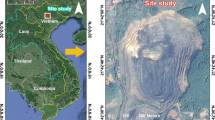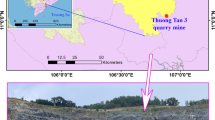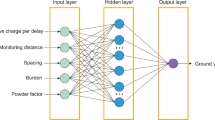Abstract
In this paper, blast-induced ground vibration (BIGV) was considered as the primary objective, and a new artificial intelligence system was proposed to predict BIGV with high accuracy based on the M5Rules and imperialist competitive algorithm (ICA), called ICA–M5Rules technique. Accordingly, the ICA was considered to optimize the M5Rules based on the rules of the M5 model, as well as the prune and smooth procedures. To evaluate the effectiveness of the proposed ICA–M5Rules technique, random forest (RF), classical M5Rules, and support vector machine (SVM) were developed as the benchmark techniques to compare with the proposed ICA–M5Rules technique. Besides, two existing empirical equations were each used to develop models based on the experimental datasets to estimate BIGV for comparison with the proposed ICA–M5Rules model. A case study of a quarry mine in Vietnam was adopted for the developed (ICA–M5Rules, M5Rules, RF, SVM, empirical) models based on 125 blasting events. Mean absolute error, root-mean-squared error, and determination of coefficient (R2) were applied and computed to evaluate the accuracy, as well as the performance of the developed models. The findings indicated that the proposed ICA–M5Rules model provided highest accuracy. The primary objective was appropriately addressed based on the obtained results of the developed models. As well established, the proposed ICA–M5Rules model was introduced as a new system to predict BIGV in open-pit mines accurately.

















Similar content being viewed by others
References
Ambraseys, N. (1968). Rock mechanics in engineering practice. New York: Wiley.
Amiri, M., Ghiasi-Freez, J., Golkar, B., & Hatampour, A. (2015). Improving water saturation estimation in a tight shaly sandstone reservoir using artificial neural network optimized by imperialist competitive algorithm—A case study. Journal of Petroleum Science and Engineering,127, 347–358.
Armaghani, D. J., Hasanipanah, M., Amnieh, H. B., & Mohamad, E. T. (2018a). Feasibility of ICA in approximating ground vibration resulting from mine blasting. Neural Computing and Applications,29(9), 457–465.
Armaghani, D. J., Hasanipanah, M., Mahdiyar, A., Majid, M. Z. A., Amnieh, H. B., & Tahir, M. M. (2018b). Airblast prediction through a hybrid genetic algorithm-ANN model. Neural Computing and Applications,29(9), 619–629.
Armaghani, D. J., Hajihassani, M., Sohaei, H., Mohamad, E. T., Marto, A., Motaghedi, H., et al. (2015). Neuro-fuzzy technique to predict air-overpressure induced by blasting. Arabian Journal of Geosciences,8(12), 10937–10950.
Army, U. (1998). Technical manual design and analysis of hardened structures to conventional weapons effects. Army TM5-855-1, Washington DC.
Arthur, C. K., Temeng, V. A., & Ziggah, Y. Y. (2019a). Multivariate adaptive regression splines (MARS) approach to blast-induced ground vibration prediction. International Journal of Mining, Reclamation and Environment, pp. 1–25. https://doi.org/10.1080/17480930.2019.1577940.
Arthur, C. K., Temeng, V. A., & Ziggah, Y. Y. (2019b). Novel approach to predicting blast-induced ground vibration using Gaussian process regression. Engineering with Computers. https://doi.org/10.1007/s00366-018-0686-3.
Asteris, P. G., Ashrafian, A., & Rezaie-Balf, M. (2019). Prediction of the compressive strength of self-compacting concrete using surrogate models. Computers and Concrete,24(2), 137–150.
Asteris, P. G., & Plevris, V. (2017). Anisotropic masonry failure criterion using artificial neural networks. Neural Computing and Applications,28(8), 2207–2229.
Atashpaz-Gargari, E., & Lucas, C. (2007). Imperialist competitive algorithm: an algorithm for optimization inspired by imperialistic competition. In IEEE congress on evolutionary computation. CEC 2007 (pp. 4661–4667). IEEE.
Ayala Carcedo, F. (2017). Drilling and blasting of rocks. Abingdon: Routledge.
Ayaz, Y., Kocamaz, A. F., & Karakoç, M. B. (2015). Modeling of compressive strength and UPV of high-volume mineral-admixtured concrete using rule-based M5 rule and tree model M5P classifiers. Construction and Building Materials,94, 235–240.
Breiman, L., Friedman, J. H., Olshen, R. A., & Stone, C. J. (1984). Classification and regression trees (p. 432). Belmont: International Group.
Bui, X.-N., Jaroonpattanapong, P., Nguyen, H., Tran, Q.-H., & Long, N. Q. (2019a). A novel hybrid model for predicting blast-induced ground vibration based on k-nearest neighbors and particle swarm optimization. Scientific Reports,9(1), 1–14.
Bui, X.-N., Muazu, M. A., & Nguyen, H. (2019b). Optimizing Levenberg–Marquardt backpropagation technique in predicting factor of safety of slopes after two-dimensional OptumG2 analysis. Engineering with Computers. https://doi.org/10.1007/s00366-019-00741-0.
Bui, X. N., Nguyen, H., Le, H. A., Bui, H. B., & Do, N. H. (2019c). Prediction of blast-induced air over-pressure in open-pit mine: assessment of different artificial intelligence techniques. Natural Resources Research. https://doi.org/10.1007/s11053-019-09461-0.
Ding, Z., Nguyen, H., Bui, X.-N., Zhou, J., & Moayedi, H. (2019). Computational intelligence model for estimating intensity of blast-induced ground vibration in a mine based on imperialist competitive and extreme gradient boosting algorithms. Natural Resources Research. https://doi.org/10.1007/s11053-019-09548-8.
Duvall, W. I., & Fogelson, D. E. (1962). Review of criteria for estimating damage to residences from blasting vibrations. Washington, DC: US Department of the Interior, Bureau of Mines.
Frank, E., & Witten, I. H. (1998). Generating accurate rule sets without global optimization.
Gal, T., & Greenberg, H. J. (2012). Advances in sensitivity analysis and parametric programming (Vol. 6). Berlin: Springer.
Görgülü, K., Arpaz, E., Demirci, A., Koçaslan, A., Dilmaç, M. K., & Yüksek, A. G. (2013). Investigation of blast-induced ground vibrations in the Tülü boron open pit mine. Bulletin of Engineering Geology and the Environment,72(3–4), 555–564.
Gou, Y., Shi, X., Huo, X., Zhou, J., Yu, Z., & Qiu, X. (2019). Motion parameter estimation and measured data correction derived from blast-induced vibration: New insights. Measurement,135, 213–230.
Hajihassani, M., Armaghani, D. J., Marto, A., & Mohamad, E. T. (2015a). Ground vibration prediction in quarry blasting through an artificial neural network optimized by imperialist competitive algorithm. Bulletin of Engineering Geology and the Environment,74(3), 873–886.
Hajihassani, M., Armaghani, D. J., Monjezi, M., Mohamad, E. T., & Marto, A. (2015b). Blast-induced air and ground vibration prediction: A particle swarm optimization-based artificial neural network approach. Environmental Earth Sciences,74(4), 2799–2817.
Hasanipanah, M., Amnieh, H. B., Khamesi, H., Armaghani, D. J., Golzar, S. B., & Shahnazar, A. (2018). Prediction of an environmental issue of mine blasting: An imperialistic competitive algorithm-based fuzzy system. International Journal of Environmental Science and Technology,15(3), 551–560.
Hasanipanah, M., Faradonbeh, R. S., Amnieh, H. B., Armaghani, D. J., & Monjezi, M. (2017). Forecasting blast-induced ground vibration developing a CART model. Engineering with Computers,33(2), 307–316.
Hosseini, S., & Al Khaled, A. (2014). A survey on the imperialist competitive algorithm metaheuristic: Implementation in engineering domain and directions for future research. Applied Soft Computing,24, 1078–1094.
Khandelwal, M., Kankar, P., & Harsha, S. (2010). Evaluation and prediction of blast induced ground vibration using support vector machine. Mining Science and Technology (China),20(1), 64–70.
Khandelwal, M., & Singh, T. (2006). Prediction of blast induced ground vibrations and frequency in opencast mine: A neural network approach. Journal of Sound and Vibration,289(4), 711–725.
Khandelwal, M., & Singh, T. (2009). Prediction of blast-induced ground vibration using artificial neural network. International Journal of Rock Mechanics and Mining Sciences,46(7), 1214–1222.
Koopialipoor, M., Fallah, A., Armaghani, D. J., Azizi, A., & Mohamad, E. T. (2019). Three hybrid intelligent models in estimating flyrock distance resulting from blasting. Engineering with Computers,35(1), 243–256.
Küçüksille, E. U., Selbaş, R., & Şencan, A. (2011). Prediction of thermodynamic properties of refrigerants using data mining. Energy Conversion and Management,52(2), 836–848.
Marto, A., Hajihassani, M., Jahed Armaghani, D., Tonnizam Mohamad, E., & Makhtar, A. M. (2014). A novel approach for blast-induced flyrock prediction based on imperialist competitive algorithm and artificial neural network. The Scientific World Journal, 2014, 11. https://doi.org/10.1155/2014/643715.
Mayor, R., & Flanders, R. (1990). Technical manual simplified computer model of air blast effects on building walls. Washington DC: US Department of State, Office of Diplomatic Security.
Moayedi, H., & Armaghani, D. J. (2018). Optimizing an ANN model with ICA for estimating bearing capacity of driven pile in cohesionless soil. Engineering with Computers,34(2), 347–356.
Moayedi, H., & Hayati, S. (2018). Modelling and optimization of ultimate bearing capacity of strip footing near a slope by soft computing methods. Applied Soft Computing,66, 208–219.
Mohammadi, S., Kakaie, R., Ataei, M., & Pourzamani, E. (2017). Determination of the optimum cut-off grades and production scheduling in multi-product open pit mines using imperialist competitive algorithm (ICA). Resources Policy,51, 39–48.
Mohammadnejad, M., Gholami, R., Ramezanzadeh, A., & Jalali, M. (2012). Prediction of blast-induced vibrations in limestone quarries using support vector machine. Journal of Vibration and Control,18(9), 1322–1329.
Monjezi, M., Ahmadi, M., Sheikhan, M., Bahrami, A., & Salimi, A. (2010). Predicting blast-induced ground vibration using various types of neural networks. Soil Dynamics and Earthquake Engineering,30(11), 1233–1236.
Monjezi, M., Ghafurikalajahi, M., & Bahrami, A. (2011). Prediction of blast-induced ground vibration using artificial neural networks. Tunnelling and Underground Space Technology,26(1), 46–50.
Monjezi, M., Hasanipanah, M., & Khandelwal, M. (2013). Evaluation and prediction of blast-induced ground vibration at Shur River Dam, Iran, by artificial neural network. Neural Computing and Applications,22(7–8), 1637–1643.
Nguyen, H. (2019). Support vector regression approach with different kernel functions for predicting blast-induced ground vibration: A case study in an open-pit coal mine of Vietnam. SN Applied Sciences,1(4), 283. https://doi.org/10.1007/s42452-019-0295-9.
Nguyen, H., & Bui, X.-N. (2019). Predicting blast-induced air overpressure: A robust artificial intelligence system based on artificial neural networks and random forest. Natural Resources Research,28, 893–907.
Nguyen, H., Bui, X.-N., Bui, H.-B., & Cuong, D. T. (2019a). Developing an XGBoost model to predict blast-induced peak particle velocity in an open-pit mine: A case study. Acta Geophysica,67(2), 477–490.
Nguyen, H., Bui, X.-N., Bui, H.-B., & Mai, N.-L. (2018a). A comparative study of artificial neural networks in predicting blast-induced air-blast overpressure at Deo Nai open-pit coal mine, Vietnam. Neural Computing and Applications. https://doi.org/10.1007/s00521-018-3717-5.
Nguyen, H., Bui, X.-N., & Moayedi, H. (2019b). A comparison of advanced computational models and experimental techniques in predicting blast-induced ground vibration in open-pit coal mine. Acta Geophysica. https://doi.org/10.1007/s11600-019-00304-3.
Nguyen, H., Bui, X.-N., Tran, Q.-H., Le, T.-Q., Do, N.-H., & Hoa, L. T. T. (2018b). Evaluating and predicting blast-induced ground vibration in open-cast mine using ANN: A case study in Vietnam. SN Applied Sciences,1(1), 125. https://doi.org/10.1007/s42452-018-0136-2.
Nguyen, H., Bui, X.-N., Tran, Q.-H., & Mai, N.-L. (2019c). A new soft computing model for estimating and controlling blast-produced ground vibration based on hierarchical K-means clustering and cubist algorithms. Applied Soft Computing,77, 376–386. https://doi.org/10.1016/j.asoc.2019.01.042.
Nguyen, H., Bui, X.-N., Tran, Q.-H., & Moayedi, H. (2019d). Predicting blast-induced peak particle velocity using BGAMs, ANN and SVM: A case study at the Nui Beo open-pit coal mine in Vietnam. Environmental Earth Sciences,78(15), 479. https://doi.org/10.1007/s12665-019-8491-x.
Nguyen, H., Drebenstedt, C., Bui, X.-N., & Bui, D. T. (2019e). Prediction of blast-induced ground vibration in an open-pit mine by a novel hybrid model based on clustering and artificial neural network. Natural Resources Research. https://doi.org/10.1007/s11053-019-09470-z.
Quinlan, J. R. (1987). Simplifying decision trees. International Journal of Man-Machine Studies,27(3), 221–234.
Quinlan, J. R. (1992). Learning with continuous classes. In: 5th Australian joint conference on artificial intelligence (Vol. 92, pp. 343–348). Singapore: World Scientific.
Rakovec, O., Hill, M. C., Clark, M., Weerts, A., Teuling, A., & Uijlenhoet, R. (2014). Distributed evaluation of local sensitivity analysis (DELSA), with application to hydrologic models. Water Resources Research,50(1), 409–426.
Saadat, M., Khandelwal, M., & Monjezi, M. (2014). An ANN-based approach to predict blast-induced ground vibration of Gol-E-Gohar iron ore mine, Iran. Journal of Rock Mechanics and Geotechnical Engineering,6(1), 67–76.
Shafiullah, G., Simson, S., Thompson, A., Wolfs, P. J., & Ali, A. (2008). Forecasting vertical acceleration railway wagons—A comparative study. Paper presented at the 4th international conference on data mining (DMIN’08), Las Vegas, NV.
Shang, Y., Nguyen, H., Bui, X.-N., Tran, Q.-H., & Moayedi, H. (2019). A novel artificial intelligence approach to predict blast-induced ground vibration in open-pit mines based on the firefly algorithm and artificial neural network. Natural Resources Research. https://doi.org/10.1007/s11053-019-09503-7.
Shi, X.-Z., Jian, Z., Wu, B.-B., Huang, D., & Wei, W. (2012). Support vector machines approach to mean particle size of rock fragmentation due to bench blasting prediction. Transactions of Nonferrous Metals Society of China,22(2), 432–441.
Sikora, M., Krzystanek, Z., Bojko, B., & Śpiechowicz, K. (2011). Application of a hybrid method of machine learning for description and on-line estimation of methane hazard in mine workings. Journal of Mining Science,47(4), 493–505.
Taheri, K., Hasanipanah, M., Golzar, S. B., & Majid, M. Z. A. (2017). A hybrid artificial bee colony algorithm-artificial neural network for forecasting the blast-produced ground vibration. Engineering with Computers,33(3), 689–700.
Talatahari, S., Azar, B. F., Sheikholeslami, R., & Gandomi, A. (2012). Imperialist competitive algorithm combined with chaos for global optimization. Communications in Nonlinear Science and Numerical Simulation,17(3), 1312–1319.
Wu, Y., Hao, H., Zhou, Y., & Chong, K. (1998). Propagation characteristics of blast-induced shock waves in a jointed rock mass. Soil Dynamics and Earthquake Engineering,17(6), 407–412.
Zhang, X., Nguyen, H., Bui, X.-N., Tran, Q.-H., Nguyen, D.-A., Bui, D. T., & Moayedi, H. (2019). Novel soft computing model for predicting blast-induced ground vibration in open-pit mines based on particle swarm optimization and XGBoost. Natural Resources Research. https://doi.org/10.1007/s11053-019-09492-7.
Zhou, J., Li, X., & Mitri, H. S. (2016a). Classification of rockburst in underground projects: comparison of ten supervised learning methods. Journal of Computing in Civil Engineering,30(5), 04016003.
Zhou, J., Li, E., Yang, S., Wang, M., Shi, X., Yao, S., et al. (2019). Slope stability prediction for circular mode failure using gradient boosting machine approach based on an updated database of case histories. Safety Science,118, 505–518.
Zhou, J., Li, X., & Shi, X. (2012). Long-term prediction model of rockburst in underground openings using heuristic algorithms and support vector machines. Safety Science,50(4), 629–644.
Zhou, J., Shi, X., Du, K., Qiu, X., Li, X., & Mitri, H. S. (2016b). Feasibility of random-forest approach for prediction of ground settlements induced by the construction of a shield-driven tunnel. International Journal of Geomechanics,17(6), 04016129.
Acknowledgments
The authors would like to thank Hanoi University of Mining and Geology (HUMG), Hanoi, Vietnam; Duy Tan University, Da Nang, Vietnam, and the Center for Mining, Electro-Mechanical research of HUMG.
Author information
Authors and Affiliations
Corresponding author
Rights and permissions
About this article
Cite this article
Fang, Q., Nguyen, H., Bui, XN. et al. Prediction of Blast-Induced Ground Vibration in Open-Pit Mines Using a New Technique Based on Imperialist Competitive Algorithm and M5Rules. Nat Resour Res 29, 791–806 (2020). https://doi.org/10.1007/s11053-019-09577-3
Received:
Accepted:
Published:
Issue Date:
DOI: https://doi.org/10.1007/s11053-019-09577-3




